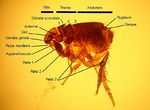Difference between revisions of "Ctenocephalides felis"
| Line 1: | Line 1: | ||
| − | {{ | + | {{review}} |
| + | {{Taxobox | ||
| + | |name = ''Ctenocephalides felis | ||
| + | |kingdom = | ||
| + | |phylum = | ||
| + | |class = ''Insecta | ||
| + | |sub-class = | ||
| + | |order = ''Siphonaptera | ||
| + | |super-family = | ||
| + | |family = ''Pulicidae | ||
| + | |sub-family = | ||
| + | |genus = | ||
| + | |species = | ||
| + | }} | ||
[[Image:Cat flea.jpg|thumb|right|150px|Cat Flea - August La Roux 2007, Wikimedia Commons]] | [[Image:Cat flea.jpg|thumb|right|150px|Cat Flea - August La Roux 2007, Wikimedia Commons]] | ||
| Line 9: | Line 22: | ||
|} | |} | ||
| − | ''Ctenocephalides felis'' is the most commonly seen flea on both cats and dogs, it is also an important intermediate host in the parasite [[Dipylidium|Dipylidium caninum]]. | + | ''Ctenocephalides felis'' is the most commonly seen flea on both cats and dogs, it is also an important intermediate host in the parasite [[Dipylidium|''Dipylidium caninum'']]. |
| − | |||
| − | |||
| − | |||
| − | |||
| − | |||
| − | |||
| − | |||
| − | |||
| − | |||
| − | |||
| − | |||
| − | |||
==Hosts== | ==Hosts== | ||
| Line 42: | Line 43: | ||
[[Category:Fleas]] | [[Category:Fleas]] | ||
[[Category:To_Do_-_Max]] | [[Category:To_Do_-_Max]] | ||
| − | [[Category: | + | [[Category:Expert_Review]] |
Revision as of 11:42, 27 July 2010
| This article has been peer reviewed but is awaiting expert review. If you would like to help with this, please see more information about expert reviewing. |
| Ctenocephalides felis | |
|---|---|
| Class | Insecta |
| Order | Siphonaptera |
| Family | Pulicidae |
| Also known as: | Cat flea |
Ctenocephalides felis is the most commonly seen flea on both cats and dogs, it is also an important intermediate host in the parasite Dipylidium caninum.
Hosts
Cats, dogs, and humans.
Identification
The adults are dark-brown, and have fascicles and laciniae adapted for piercing skin and sucking blood. They have large legs, containing resilin, adapted for jumping, and are laterally flattened, so they can easily move through the hair of the hosts. The adults have rows of spines, known as 'combs' or 'ctenidia', which are very important in the identification process. The first genal spine is 0.75 times the length of the second
Life Cycle
The female lays eggs directly on the host. These then fall off into the environment, and hatch into larvae. The eggs are strong and very resistant to environmental changes. The larvae undergo two further moults, before pupating within the cocoon (produced by the larvae.)
When the parasite is fully developed the adults emerge from the pupae, but remain within the cocoon. They will hatch out of the pupae when stimulated by movement, or heat. Overall, most of the life cycle is spent away from the host.
